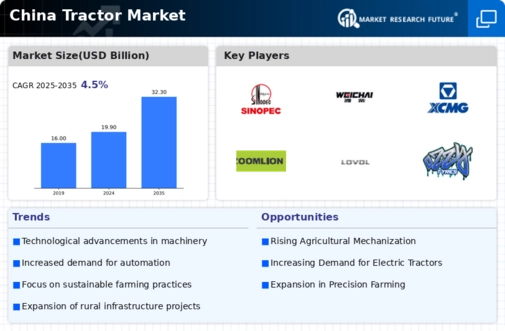Rising Agricultural Demand
The tractor market in China is experiencing a surge in demand driven by the increasing need for efficient agricultural practices. As the population continues to grow, the demand for food production rises, necessitating the adoption of advanced farming techniques. In 2025, the agricultural sector is projected to contribute approximately 7% to China's GDP, highlighting the importance of mechanization. Tractors play a crucial role in enhancing productivity, enabling farmers to cultivate larger areas with reduced labor costs. This trend indicates a shift towards modern farming methods, where tractors are essential for meeting the food supply challenges. The tractor market is likely to benefit from this rising agricultural demand, as farmers seek to invest in more efficient machinery to boost their output.
Rural Infrastructure Development
The development of rural infrastructure in China is a critical driver for the tractor market. Improved roads, irrigation systems, and storage facilities enhance the accessibility and efficiency of agricultural operations. As rural areas become more connected, the demand for tractors is likely to increase, as farmers seek to optimize their operations. In 2025, investments in rural infrastructure are projected to reach $50 billion, facilitating better transportation of goods and services. This infrastructure development not only supports existing farmers but also encourages new entrants into the agricultural sector, further driving the need for tractors. The tractor market stands to gain significantly from these advancements, as enhanced infrastructure enables more effective use of agricultural machinery.
Shift Towards Sustainable Practices
The tractor market in China is witnessing a notable shift towards sustainable agricultural practices. As environmental concerns gain prominence, farmers are increasingly adopting eco-friendly technologies and practices. This trend is reflected in the growing demand for tractors that are designed to minimize environmental impact, such as those utilizing alternative fuels or electric power. By 2025, it is projected that the market for sustainable tractors will grow by 20%, driven by both consumer preferences and regulatory pressures. This shift not only aligns with The tractor market as a key player in the transition towards greener agriculture. Manufacturers are likely to respond by innovating and producing more sustainable options to meet this emerging demand.
Technological Integration in Farming
The integration of advanced technologies in farming practices is reshaping the tractor market in China. Innovations such as precision agriculture, GPS-guided tractors, and automated systems are becoming increasingly prevalent. These technologies enhance operational efficiency and reduce resource wastage, aligning with the growing emphasis on sustainable farming. In 2025, it is estimated that around 30% of tractors sold in China will incorporate smart technology features, indicating a shift towards more intelligent farming solutions. This trend not only improves productivity but also attracts a new generation of farmers who are tech-savvy and eager to leverage these advancements. The tractor market is poised to expand as these technological integrations become standard in agricultural practices.
Government Initiatives for Modernization
The Chinese government is actively promoting modernization in the agricultural sector, which significantly impacts the tractor market. Initiatives aimed at enhancing agricultural productivity through mechanization are being implemented, with substantial investments allocated for this purpose. In recent years, the government has introduced subsidies and financial incentives to encourage farmers to adopt modern machinery, including tractors. These initiatives are expected to increase the adoption rate of tractors among small and medium-sized farms, which constitute a significant portion of the agricultural landscape. By 2025, it is anticipated that government support will lead to a 15% increase in tractor sales, reflecting the commitment to modernizing the agricultural sector and improving overall efficiency.

















Leave a Comment